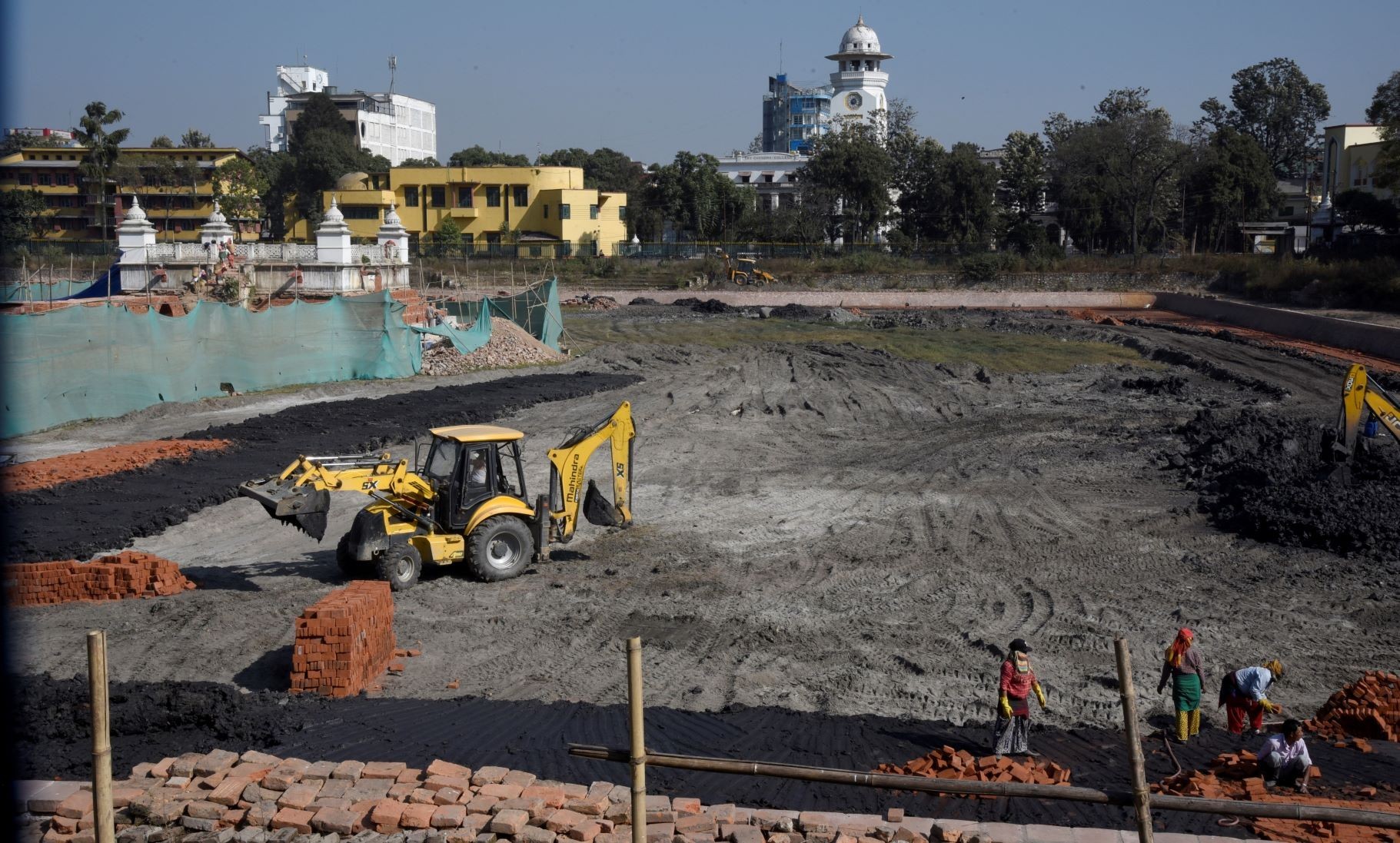Use of excavator in Rani Pokhari reconstruction draws flak

By A Staff Reporter
Kathmandu, Dec. 5: Some cultural activists have criticised the use of an excavator in the ongoing Ranipokhari reconstruction process.
The Ranipokhari Consumers Committee (RCC) has started to use the single excavator for filling up the ground section by black soil, mixing black soil, carrying it at the working site and leveling the ground soil.
Some workers are also applying bricks on the black soil.
Ajay Sthapit, president of RCC, said that they were using the excavator only after consulting and discussing with the concern bodies.
“We are using the machine without damaging the cultural values and aspects of the historical pond,” Sthapit said.
Earlier, the committee had used manpower to apply the black soil in the ground section. But when it took more time and budget than the estimated cost and time to complete the work manually, the RCC opted to use an excavator.
“As the use of only manual force was both time and budget consuming, we decided to use an excavator to complete the reconstruction work in the stipulated timeframe,” he said.
Earlier, the committee had brought the Bhaktapur-based workers to rebuild the historical pond. Around 30 to 40 women contributed their labour, ideas and time to rebuild the historic pond for about eight months.
The work quality by using the dozer and the manpower is same, but the reconstruction process is moving in a faster pace after the use of the excavator, he said.
None of the Bhaktapur-based manpower is engaged in the reconstruction process after Dashain festival. They refused to come to work stating that the committee expelled them.
Sthapit said that the workers blamed that the committee used them in the hard working section and now it started using an excavator in the easy section by replacing them.
In reality, the committee had not expelled them, he added.
“Completing the ground work by using only the manpower became impossible within the given deadline, and we started using the excavator to complete the work in time,” said Sthapit.
Still there are manual works in the wall section of the pond and the committee will call the Bhaktapur team to complete it, he said.
According to him, 15 per cent manual work was yet to be completed.
“If the Bhaktapur team denies, we will call the Kirtipur-based manpower to complete the remaining work,” he said.
‘‘Our plan is to complete the ground work and wall section work by mid- February next year,’’ he said.
Ganapati Lal Shrestha, an activist, blamed that the committee used the dozer replacing the Bhaktapur-based skilled manpower to save money.
The committee had initiated reconstruction of the pond from the day of Shivaratri on March 4 this year.
The reconstruction cost is estimated at Rs. 95 million.
After the Dashain festival, the reconstruction process was halted showing the shortage of black soil.
Works in the Ranipokhari have been divided in two phases.
The committee has been handling works on the wall and ground sections of the pond while the Construction Company, CA/Tulsi Contractors, has been handling the reconstruction of the Balgopaleshwar Temple, bridge and a garden surrounding the pond.
The agreed budget for the reconstruction is Rs. 140 million.
Reconstruction works of Balgopaleshwar Temple, which lies in the middle of the historic Ranipokhari, had begun in August, and the bridge section will complete by mid-May next year.
The temple is being rebuilt in traditional Granthakut style of the Malla era. The temple was built by King Pratap Malla in the Granthakut style in 1670.
The original temple was destroyed in the earthquake of 1934. After the earthquake, the temple was later reconstructed in Gumbaz model by the Rana rulers.
According to historians and activists, the temple was rebuilt by Jung Bahadur Rana in 1905 making changes to its original design.
Recent News

Do not make expressions casting dout on election: EC
14 Apr, 2022
CM Bhatta says may New Year 2079 BS inspire positive thinking
14 Apr, 2022
Three new cases, 44 recoveries in 24 hours
14 Apr, 2022
689 climbers of 84 teams so far acquire permits for climbing various peaks this spring season
14 Apr, 2022
How the rising cost of living crisis is impacting Nepal
14 Apr, 2022
US military confirms an interstellar meteor collided with Earth
14 Apr, 2022
Valneva Covid vaccine approved for use in UK
14 Apr, 2022
Chair Prachanda highlights need of unity among Maoist, Communist forces
14 Apr, 2022
Ranbir Kapoor and Alia Bhatt: Bollywood toasts star couple on wedding
14 Apr, 2022
President Bhandari confers decorations (Photo Feature)
14 Apr, 2022











